#lespedeza
Explore tagged Tumblr posts
Text

Bushclover (Lespedeza Bicolor) Kanazawa, Japan
#photographers on tumblr#nature#flowers#purple#autumn#fall#pink#floral#flores#otoño#bushclover#lespedeza#lespedeza bicolor#kanazawa#japan#original photographers#original photography#vertical
134 notes
·
View notes
Photo
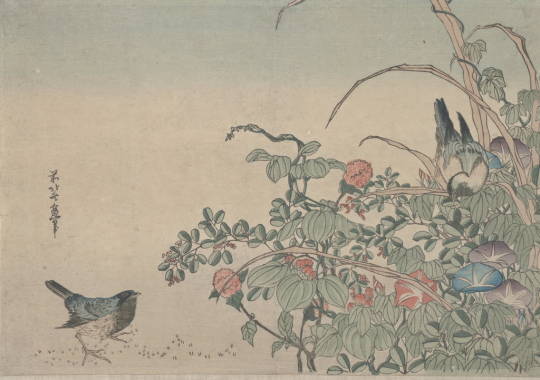
Bluebirds with Morning Glories and Lespedeza, c.1833 by Utagawa Hiroshige (1833, Holzschnitt)
#bluebird#Utagawa Hiroshige#Hiroshige#bird#blue bird#morning glory#morning#Lespedeza#flowers#nature#asian#asian art#artwork#woodblock print#japanese woodblock#blumen#botanical#botany#wildlife#museum#art gallery
124 notes
·
View notes
Text

Lespedeza bicolor / Shrubby Bushclover at the Sarah P. Duke Gardens at Duke University in Durham, NC
#Lespedeza bicolor#Lespedeza#Fabaceae#Shrubby Bushclover#Shrub lespedeza#Bicolor lespedeza#Bushclover#invasive plants#Plants#Flowers#Nature photography#photography#photographers on tumblr#Sarah P. Duke Gardens#Duke Gardens#Duke University#Durham#Durham NC#North Carolina#🌺🌻
9 notes
·
View notes
Text



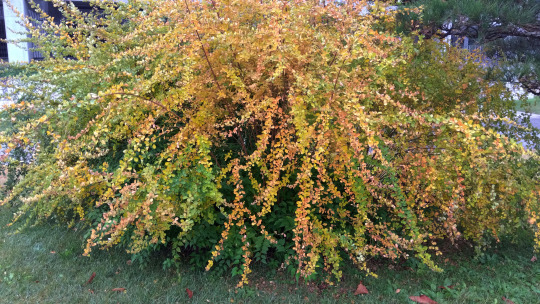
Autumn 2024_53 4 seasons in the neighborhood, Japan
#autumn#autumn leaves#autumn colors#nature#four seasons#japan#enkianthus#japanese enkianthus#Sasa veitchii Rehd#Kuma Bamboo Grass#Bush clover#lespedeza
2 notes
·
View notes
Text




Lespedeza bicolor
57 notes
·
View notes
Text

神社まで散歩に行く途中の
住宅の垣根で咲いていた、
ピンク色の「ヤマハギ(山萩)」の花。
ハギ属。
学名:Lespedeza bicolor
撮影:iPhone14 Pro Max
42 notes
·
View notes
Text
My Garden Flowers Part 4
All photos mine. The Pennsylvania pellitory is edited for because the plant app I took the photo in washed it out. The scarlet bee balm is edited for colour because that old phone's camera sucked.























In order of appearance:
091. Pennsylvania Pellitory (Parietaria pensylvanica) A common garden weed, but as it's native it can stay in some places.
092. Perennial Flax (Linum perenne) In spite of the name she sadly didn't come back or reseed. Shame because she looked really nice in that area. Oh well. I'll have to try in another spot.
093. Showy Tick-Trefoil (Desmodium canadense) She tricked me! I thought she hadn't made it as she hadn't come up by late June so I got another one and put her in a different area...only for this one to come up. And if you're thinking, oh, she's just a late bloomer, I should have waited, well, she came up in May this year. Because of course she did.
094. Virginia Mountain Mint (Pycnanthemum virginiana) She smells like something you'd want to season steak or something with and would probably do very well at that but I've never cooked a steak before. Maybe I'll try her in pesto some day.
095. Devil's Tongue (Opuntia humifusa) She flowered for the first time last year and is flowering again this year!
096. Fragile Prickly Pear (Opuntia fragilis) Not pictured as she hasn't flowered yet. She's still quite little. I might break off a piece of her to try growing in that really tough spot. If she can survive summer to winter in a pot, surely that area shouldn't be too harsh for her.
097. Thrift Seapink (Armeria maritima) She's tough enough to survive winter in a pot and did so for three years, but last winter was apparently too much for her. Again, I think it was just too dry. She was pretty much only happy there in the spring and fall, though, so maybe it's just as well. The new one I planted elsewhere seems happy in all seasons.
098-099. Lance-Leaved Tickseed (Coreopsis lanceolata) Usually only the cultivars have those red markings! I'm assuming there's been some cross-pollination with other gardens because I did not plant that. My tickseeds are all straight amber. Unless she independently produced the colour on her own as a sport. Interestingly enough, none of them are showing that colouration this year.
100. White Sagewort (Artemisia ludoviciana) I wasn't actually supposed to have this one. I'd ordered the less aggressive A. frigida, but oh well. Maybe she'll attract American lady butterflies some year. Not pictured as she hasn't flowered yet. She smells like something you'd use to season stuffing.
101. Blue-Eyed Grass (Sisyrinchium angustifolium) After several attempts in different areas, trying my hardest to follow what the information online said she would need, but somehow failing, this one at last seems to be doing fine.
102. Dotted St. John's Wort (Hypericum punctata) I didn't plant that. Either a gift of the wildlife or a dormant seed came to life when I removed the grass.
103. Roundhead Bushclover (Lespedeza capitata) Another one I've had several attempts with, but she seems to like it there.
104. Curlycup Gumweed (Grindelia squarrosa) Flowered nicely that year and I thought she didn't reseed because she didn't come up last year but there is a plant this year! It's good to remember that seeds can lie dormant for some time. :)
105. Upright Prairie Coneflower "Mexican Hat" (Ratibida columnifera) This is a cultivar and has since passed away during the winter.
106. Rocky Mountains Bee Plant (Cleomella serrulata) She reseeded for several years but apparently not this one. Hopefully they're just skipping a year and will come up next spring. If not I'll have to attempt a different area. Anyway, pretty much the whole plant is edible with preparation, and lots of insects love the flowers.
107. Spotted Horsemint (Monarda punctata) Beloved of many insects. Sometimes I just like to sit next to her and watch the activity.
108. Wild Black Sweet Tomato (Solanum ptychanthum) She began as a weed on this property, but not anymore. She is a welcome part of my native garden with her wonderful fruits in the summer.
109. Common Sunflower (Helianthus annuus) The wild type this time, but no evidence of reseeding this year. :(
110. Alpine Rock Cress (Arabis alpina) She flowers in April before most trees have even blossomed.
111. Field Chickweed (Cerastium arvense) By the time I got to plant her in the fall some years ago, I was sure she'd die over the winter. She didn't but struggled through the warm months. But she managed to bounce back the following spring and makes a nice little carpet now.
112. Yellow Wild Indigo (Baptisia tinctoria) Not pictured as she hasn't flowered yet.
113. Butterflyweed (Asclepias tuberosa) Finally decided to flower this year! She is the only orange species of milkweed native this far north.
114. Upright Prairie Coneflower (Ratibida columnifera) The wild type. Didn't like that spot in the winter either, so I'm trying a different area this year.
115. Fringed Blue Aster (Symphyotrichum ciliolatum) Not the most colourful or compact, but makes a nice spray of pale blue violet over her dark green foliage.
116. Bluestem Goldenrod (Solidago caesia) Not pictured as she hasn't flowered yet, but she's likely to this year.
117. Black Walnut (Juglans nigra) She's been on the property long before I got here. Not pictured as I haven't gotten any pictures yet since she is very tall.
118. Field Pussytoes (Antennaria neglecta) Compact and low-growing foliage create a mat, with these delicate stems poking out with what looks like kitten toes that pass for the plant's flower.
119. Aster (Symphyotrichum) I don't know what she is yet, but she decided to take up residence with my pussytoes and I guess that's okay. Haven't gotten pictures of the flowers yet.
120. Dotted Blazing Star (Liatris punctata) Not pictured as she hasn't flowered yet.
#blackswallowtailbutterfly#my photos#photography#my garden#garden flowers#native plant gardening#Parietaria pensylvanica#Linum perenne#Desmodium canadense#Pycnanthemum virginiana#Opuntia humifusa#Armeria maritima#Coreopsis lanceolata#Sisyrinchium angustifolium#Hypericum punctata#Lespedeza capitata#Grindelia squarrosa#Ratibida columnifera#Symphyotrichum ciliolatum#Antennaria neglecta
8 notes
·
View notes
Text
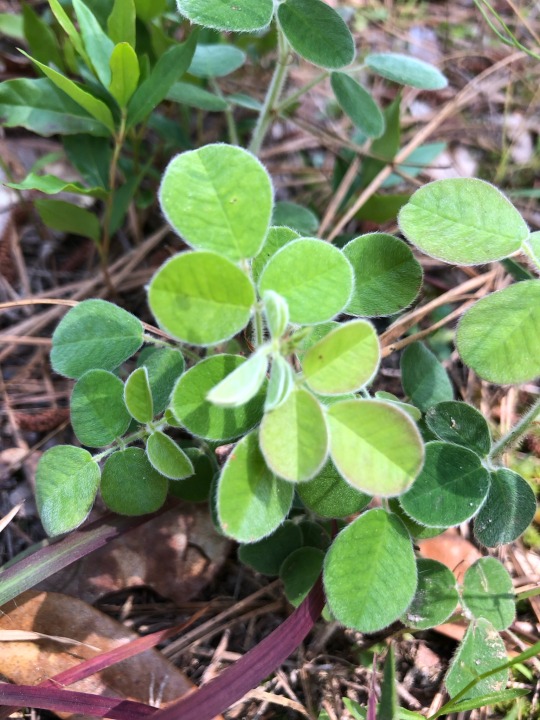

Native clover! Lespedeza hirta, aka hairy bush clover! I’ve only found one specimen on my parents property, so I was pretty excited to find a small patch this year!
16 notes
·
View notes
Text

萩が花盛り(9月15日)
Lespedeza dwubarwna (Lespedeza bicolor)
shrubby bushclover, shrub lespedeza, or bicolor lespedeza (Lespedeza bicolor)
#Lespedeza bicolor#shrubby bushclover#shrub lespedeza#bicolor lespedeza#Lespedeza dwubarwna#ハギ#萩#flowers#kwiaty#japan#花
1 note
·
View note
Text
Wildflower Walk ?
Hello everyone! I hope this post finds you all well. I apologize for not posting for a while. It has been a weird summer for sure with the heat and drought. I was busy with the garden picking sweet corn and green beans right up until August 17. Somehow I managed to get 455 ears of sweet corn in the freezer, and thanks to the ‘Provider’ green beans, 34 quarts of green beans. Of course, not all the…
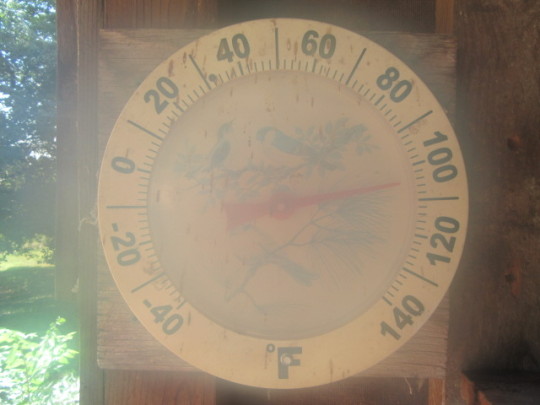
View On WordPress
#Ambrosia bidentata (Lanceleaf Ragweed)#Asclepias hirtella (Prairie/Tall Green Milkweed)#Asclepias syriaca (Common Milkweed)#Bidens aristosa (Tickseed Sunflower or Bearded Beggarticks)#Datura stramonium (Jimson Weed)#Elephantopus carolinianus (Leafy Elephant&039;s Foot)#Erechtites hieraciifolius (Fireweed/Pilewort)#Erigeron annuus (Annual or Daisy Fleabane)#Etc.)#Eupatorium serotinum (Late Boneset)#Impatiens capensis (Jewelweed)#Lespedeza cuneata (Chinese Bushclover)#Persicaria hydropiper (Water Pepper)#Persicaria pensylvanica (Pinkweed)#Phytolacca americana (American Pokeweed)#roton capitatus (Hogwort/Woolly Croton/Goatweed)#Rudbeckia hirta (Black-Eyed Susan)#Sida spinosa (Prickly Fanpetals)#Solanum sarrachoides (Hairy Nightshade)#Solidago sp. (Goldenrod)#Symphyotrichum lateriflorum (Calico Aster)#Tridens flavus (Purpletop#Tripsacum dactyloides (Eastern Gamagrass)#Verbesina virginica (White Crownbeard/Frostweed)#Vernonia missurica (Missouri Ironweed)
0 notes
Text

山萩[Yamahagi] Lespedeza bicolor
Hagi is one of the seven autumnal grasses and is a seasonal word for autumn in the haiku world. In reality, the flowering season is from about June to September, and strictly speaking, its season word also refers to "early" autumn.
The tree in the photo is in a low mountain range where I sometimes go in search of flowers, and it produced flowers little by little around summer in previous years. But not so this year, and I did not see any of them at that time.
However, when I went out a couple of days ago, it was in full bloom. This summer was extremely hot, and that may have had an impact.
These flowers, which had been brightly decorating a part of the thicket, somewhat seemed to have deepened in color.
ゆきゆきて たふれ伏すとも 萩の原
[Yuki yukite taorefusu tomo hagi no hara] Keep going and going, even if I used up all my energy and collapse halfway through, I want that place to be a field of Hagi in bloom. By Kawai Sora when he traveled with Matsuo Bashō along the Oku no Hosomichi https://en.wikipedia.org/wiki/Sora's_Diary
41 notes
·
View notes
Text
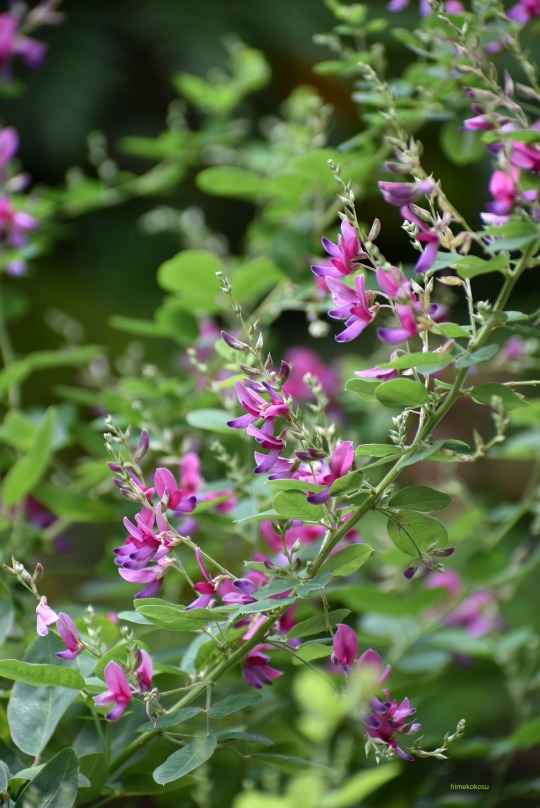

Lespedeza thunbergii subsp. patens
145 notes
·
View notes
Text

Lespedeza thunbergii f. alba / White Bushclover at the Sarah P. Duke Gardens at Duke University in Durham, NC
#Lespedeza thunbergii f. alba#Lespedeza thunbergii#Lespedeza#Fabaceae#White Bushclover#Thunberg's Bushclover#Thunberg's lespedeza#Shrub lespedeza#Plants#Flowers#Nature photography#photography#photographers on tumblr#Sarah P. Duke Gardens#Duke Gardens#Duke University#Durham#Durham NC#north carolina#🌺🌻
3 notes
·
View notes
Text





Autumn 2024_2 4 seasons in the neighborhood, Japan
#Lespedeza#trees#nature#japan#forest#four seasons#flowers#ginkgo#Trametes gibbosa#autumn#fall#Aesculus turbinata#horse chestnut
6 notes
·
View notes
Text
Flower Friday
Thank you to @a-noble-dragon and @jamilas-pen for tagging me.
Fall seems to have arrived this week. The black-eyed susans and cherry tomatoes are hanging in there a bit longer:


The sunflowers are not:

Two kinds of little purple things seem to be doing well still. My app says these are a scarlet kammetjie and a shrub lespedeza:


The snails and slugs have been out:

As well as other kinds of suburban wildlife:


Tagging @mostlyinthemorning @ramonaflow @tyfinn @flowertrigger @mammameesh
@stargazer56 @saraminia @dytzyone @olinsghost @smallumbrella369
for looking at or sharing a little nature, or just saying hi.
18 notes
·
View notes
